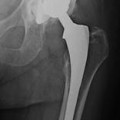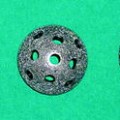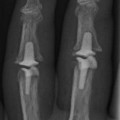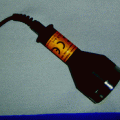© Springer-Verlag Italia 2014
Carlina V. Albanese and Carlo Faletti (eds.)Imaging of Prosthetic Joints10.1007/978-88-470-5483-7_55. Material Implant
(1)
Department of Orthopedics and Traumatology, Policlinico Umberto I, University of Rome “Sapienza”, Via del Policlinico 155, 00161 Rome, Italy
5.1 Introduction
The definition of biomaterial by National Institute of Health (NIH) is any substance (other than a drug) or combination of substances, synthetic or natural in origin, which can be used for any period of time, as a whole or as a part of a system which treats, augments, or replaces any tissue, organ, or function of the body.
This definition clearly satisfies the requirements in the orthopedic field where certain diseases such as osteoarthritis, fractures, and tumors require materials to replace bone or cartilage.
Most orthopedic medical devices are used in joint replacement or fracture management procedures, and this is reflected in their global sales, which totaled approximately $12 billion and $1.5 billion, respectively, in 2000 [1].
The treatment of orthopedic diseases has changed considerably over the past decades, allowing patients to live longer and better-quality lives. The introduction of new biomaterials has contributed much to this success.
5.2 Metal
Several material properties make metals extremely useful as components in orthopedic medical devices. These properties include corrosion resistance, strength, rigidity, stiffness, long fatigue life, fracture toughness, and biocompatibility.
These important material properties have led to the widespread use of metal alloys as load-bearing implant materials.
Metallic materials actually applied in orthopedic surgery include stainless steel (i.e., plates), commercially pure titanium (i.e., plates), and titanium alloy (i.e., intramedullary nails, total joint prostheses). The choice of the type of metal must take account of certain important considerations such as the joint anatomy, the joint mechanical strength, and the characteristics of the metals.
5.3 Stainless Steel
Stainless steel is a metal used in orthopedic implant, which has a low content of impurities. All stainless steels are corrosion-resistant chiefly because of their chrome content and the type of oxyde surface chrome helps to create. Sherman [2] introduced in 1912 this kind of metal for plates and screws. Surgical stainless steel alloys (316L) made with varying amounts of iron, chromium, and nickel are presently used in the manufacture of prostheses. The low carbon (L) in surgical stainless steel diminishes corrosion and decreases adverse tissue responses and metal allergies.
Fatigue failure and relatively high corrosion rates make it a poor candidate for the manufacture of modern joint replacement implants [3, 4]. While many implants are still manufactured from this excellent material, its use is relegated mainly to plates, screws, and intramedullary devices that are not meant to be weight bearing for an extended period. Stainless steels without nickel have been recently developed to use them in patient with nickel sensitivity. The Ni-free compositions appear to possess an extraordinary combination of attributes for potential implant applications in the future.
5.4 Cobalt-Based Alloys
Cobalt–chrome–molybdenum is the most important implant alloy used in joint arthroplasty. This alloy has excellent wear resistance than other metallic materials and polymers; biocompatibility and corrosion-resistant as compared to other metallic materials; and high toughness in comparison to ceramics.
5.5 Titanium and Titanium-Based Alloys
Titanium-based alloys have excellent properties for use in porous forms for biologic fixation of prostheses. Levanthal [5] was the first to make use of titanium in surgery.
Titanium and titanium-6 % aluminum-4 % vanadium (Ti-6Al-4V) are known to be biocompatible and corrosion-resistant for this is the most common titanium alloy used in orthopedic implant.
5.6 Ceramic
The first to use ceramic in orthopedics was Rock in 1930, not for joint replacement but like bone substitute (tricalciumphosphate). Sandhaus in 1965 proposed alumina for joint replacement called Degussit AL 23. The ceramic was then reintroduced in 1970, when a rapid development of the application of alumina in orthopedics started, mainly for hip replacement. Alumina was used initially for femoral head and later acetabular cups [6].Zirconia called tetragonal zirconia polycrystals (TZP) was introduced in the end of 1970s [7]. TZP was characterized by a structure of high density, fine grain size and high purity, and twice the strength and toughness of alumina. In 1990, this material had been proved to be biocompatible. The applications in modern orthopedic surgery are femoral heads and insert for acetabular cup.
5.7 Characteristics of Modern Ceramics
Theoretically, alumina is 10 times harder than cobalt-chrome [10]; alumina, with a hardness of approximately 2,000 VH (Vickers Hardness), is one of the hardest materials. [11]. This hardness provides improved scratch resistance. Another advantage is the improved lubrication due to its lower wetting angle. This permits better wettability, especially when coupled with the formation of a microfilm of lubrication on the surface of ceramics. In addition, strong bonding between the oxygen and aluminum ions provides extremely good corrosion resistance, leading to better biocompatibility, and because they are inert, there is no concern about allergic reactions [10, 12]. As a result, modern ceramic has much less wear rate compared with other biomaterials [13, 14] These favorable qualities are particularly desirable for implants in high-demand patients, such as young or more active patients [15, 16]. Alumina ceramics are brittle and have no way to deform without breakage [17]. Improvements in ceramic components and design changes have reduced failure rates of THA over the past 30 years. Starting with a failure rate of 1:100 in the initial phase [18, 19], the incidence of ceramic fractures has been reduced nowadays to 1:25,000 [20]. Because of its improved wear characteristics and durability, COC technology has gained widespread popularity. Efforts are continually being made to improve implant design. Nowadays, AMC ceramic material, with its superior mechanical properties and excellent wear behavior, is a promising new material for prostheses. Up until now, no complications have been reported in AMC THA. It is now possible to solve the existing longevity problems currently burdening many total joint systems in young and active patients [21].
5.8 Ultrahigh Molecular Weight Polyethylene
Polyethylene is a material that has a wide variety of molecular and microstuctural differences like molecular weight, degree of branching, crystallinity, and degree of cross linking. This variety of form has different properties.
Ultrahigh molecular weight polyethylene (UHMWPE) possesses excellent sliding properties, high impact strength, high fatigue resistance, and excellent biocompatibility. For over four decades, UHMWPE has been used as one-half of the metal- or ceramic-on-plastic bearing couple in total joint replacement (TJR) components due to its toughness, durability, and biological inertness.
UHMWPE wears at a rate of approximately 0.1 mm/year, but this is variable and influenced by physical activity of the patient, patient weight, size of femoral head (32 vs. 28 mm), roughness of the metallic counterface, and oxidation of the UHMWPE. Most medical devices are sterilized by exposure in gamma radiation. In the first half of the 1990s became widely known in the orthopedic device industry that this method to sterilize implants was causing break the chains of UHMWPE. It can reduce the molecular weight with loss of ductility and a decrease in strength. The final effect is more susceptible to wear. Sterilizing the polyethylene with gamma radiation in an inert gas such as nitrogen or argon actually made the polyethylene much stronger.
5.9 Joint Replacement Interface
5.9.1 Ceramic-on-Ceramic
Boutin [22] reported the first experience of ceramic-on-ceramic (COC) on total hip arthroplasty (THA) in 1970. Early and midterm COC THA clinical outcome reports from the initial experience in the USA have been encouraging [23, 24]. At a minimum of 18.5-year follow-up, Hamadouche et al. [25] reported minimal wear, limited osteolysis, and a low rate of complication with COC THA.
However, some important disadvantages of early-generation COC articulations have been reported. Early ceramic component materials were of large grain size and contained a lot of impurities, resulting in unacceptable component fracture rates [15, 26] For instance, relatively high rates (up to 13 %) of component fracture in the first-generation ceramics have been reported in the literature [27].
Although the second-generation ceramics has been much improved, the reported fracture rate is still up to 0.014 %. [28, 29] With the development of manufacturing processes such as hot isostatic pressing, laser etching, and proof testing, the modern ceramic component material which is now produced has better characteristics (the third-generation ceramic Biolox Forte [Ceram Tec Medical Products, Plochingen, Germany], approved by the US FDA in 2003) [30, 31].
The average size of the grains has been reduced from 3.2 to 1.8 mm, and the bending strength has been increased to 580 MPa for alumina ceramics [32].
The third-generation alumina ceramics commercialized today benefit from all of these improvements, and the fracture rate has been reduced to 0.004 % [33]. Compared to the old alumina ceramic in previous clinical studies, for which the 10-year survival rate was 90.8 %, third-generation, highly purified alumina has an almost 100 % 10-year survival rate [34].
The ceramic materials that are mainly used in total hip and knee arthroplasty can be divided into alumina, zirconia, and composite ceramics. Other ceramic surface modifications, including oxidized zirconium, diamond-like carbon, and titanium nitride as well as the nonoxide ceramics, silicon nitride and silicon carbide, are hardly used or are in development [35].
5.9.2 Metal-on-Metal
The metal-on-metal (MoM) articulations in THA were widely used between 1960 and 1975. The McKee–Farrar and other first-generation prostheses failed at a high rate because impingement caused early component loosening. The problem of early component loosening was corrected by improved component design and better manufacturing quality. Second-generation MoM total hip replacements (THR) have experienced short and medium-term success as assessed by Harris hip scores and patient self-assessment [36].
Stay updated, free articles. Join our Telegram channel

Full access? Get Clinical Tree








